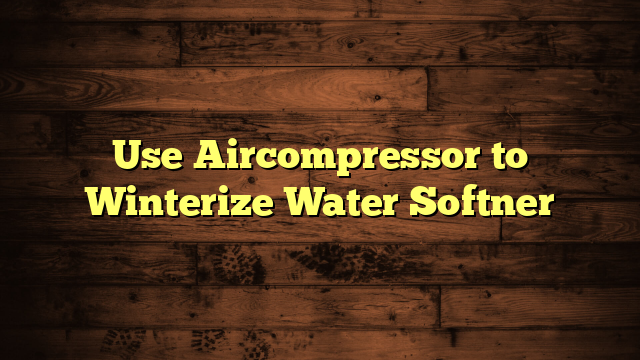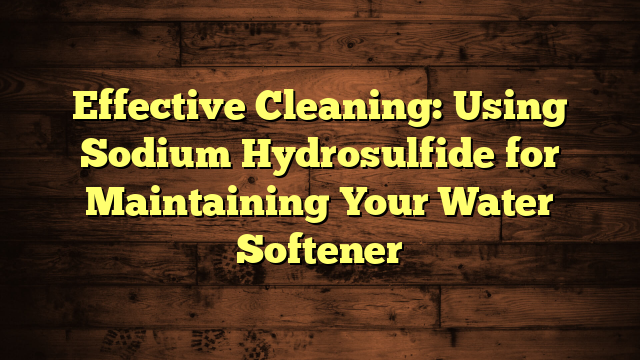How Much Water Should Be in a Water Softner?
If you think the amount of water in your water softener doesn't matter, you're in for a surprise. Maintaining the right water level is essential for ensuring your system runs efficiently and effectively. But how do you determine the best amount? There are several factors to take into account, from the type of softener you have to the salt levels you maintain. Let's explore what you need to know to keep your softener in top shape and avoid potential pitfalls.
Key Takeaways
- Maintain the brine tank water level about one inch above the salt for proper saturation.
- Keep salt levels in the brine tank at ¼ to ⅓ full to prevent bridging.
- Regularly inspect the brine tank monthly to ensure optimal water levels and efficiency.
- Low water levels can lead to ineffective regeneration and hard water issues.
- Proper water concentration in the brine solution is critical for effective softening.
Importance of Water Levels
When it comes to maintaining an efficient water softener, understanding the importance of water levels is vital. Proper water balance guarantees your system runs effectively, preventing issues that can disrupt performance. If the water levels are too low, the softener won't regenerate properly, leading to hard water issues in your home.
Conversely, overly high water levels can lead to wasted resources and increased costs.
To optimize efficiency, you should regularly check and adjust the water levels in your softener. Ideally, the brine tank should be filled to the appropriate level, allowing for effective salt saturation. This saturation is essential for the ion exchange process that softens water.
When the water balance is maintained, you enhance the lifespan of your softener and boost its overall performance.
Don't forget to monitor the salt levels as well. Insufficient salt can lead to inefficient regeneration cycles, while excessive salt can cause scaling and other problems.
Types of Water Softeners
Understanding the different types of water softeners can help you make informed decisions about which system best suits your needs. There are mainly three types: salt-based, salt-free, and dual-tank water softeners.
Salt-based softeners are the most common and typically use sodium or potassium salt to remove hard minerals like calcium and magnesium. The efficiency of these softeners largely depends on the salt types used, as some are more effective than others.
Salt-free softeners, on the other hand, don't actually remove minerals; instead, they condition the water to prevent scaling. While they can be easier to maintain, their softener efficiency mightn't match that of traditional salt-based systems, especially in areas with very hard water.
Lastly, dual-tank softeners offer an advantage by allowing continuous softening. When one tank regenerates, the other is in use, so you never run out of softened water.
Choosing the right type can depend on your water hardness, budget, and how much maintenance you're willing to perform. Each type has its pros and cons, so weigh those carefully to find the best fit for your home.
Factors Affecting Water Levels
When it comes to water levels in your softener, several factors come into play.
Your tank size, the hardness of your water, and how often the system regenerates all greatly impact how much water you should maintain.
Understanding these elements helps guarantee your water softener operates efficiently and meets your household needs.
Tank Size Considerations
Choosing the right tank size for your water softener plays an essential role in maintaining ideal water levels. The brine tank is a vital component in this system, and its size must match your softener capacity to guarantee efficient operation.
If the tank's too small, it won't hold enough salt or water, leading to incomplete regeneration cycles. Conversely, an oversized brine tank can result in excessive water levels, causing potential overflow issues.
When selecting a tank, consider your household's water usage and the hardness of your water supply. The more water you use, the larger the tank you'll need to support the softener's capacity effectively.
It's also wise to check the manufacturer's specifications for recommended tank sizes based on your model.
Regularly monitoring the water levels in your brine tank is essential. You want to maintain the appropriate level, typically around half-full, to guarantee peak operation.
If you find yourself constantly adjusting the water levels, it might be time to reassess the tank size. By understanding these factors, you can guarantee your water softener remains efficient and effective for your home's needs.
Water Hardness Levels
Many factors influence water hardness levels, which can greatly affect how much water your softener needs. Water hardness measurement is typically expressed in grains per gallon (GPG) or parts per million (PPM). The higher the hardness level, the more minerals like calcium and magnesium are present.
These minerals can lead to various problems in your home, including scale buildup in pipes and appliances, reduced soap effectiveness, and even skin irritation during bathing.
Understanding the effects of hardness is essential for optimizing your softener's performance. If your water is particularly hard, your softener must work harder and use more water to regenerate. Conversely, if your water is relatively soft, your softener can operate more efficiently, saving water and salt.
You can easily check your water hardness through local water reports or test kits available at home improvement stores. Once you know your hardness level, you can adjust your softener's settings accordingly, ensuring it runs smoothly and effectively.
Keeping tabs on these factors will help you maintain your system and prolong its lifespan, ultimately benefiting your household's comfort and efficiency.
Regeneration Frequency Impact
The frequency of regeneration greatly impacts how much water your softener uses.
If you want to maximize efficiency optimization, understanding your regeneration intervals is essential.
Here are four factors that affect water levels in your softener:
- Water Hardness: The harder your water, the more often your softener needs to regenerate, using more water in the process.
- Household Size: Larger families typically use more water, which can lead to increased regeneration frequency and higher water consumption.
- Usage Patterns: If you have a high demand for softened water, you may find yourself regenerating more frequently than expected.
- Salt Type and Quality: Different salts can affect the efficiency of the regeneration process, influencing how much water your softener uses during each cycle.
Optimal Water Level Guidelines
When it comes to your water softener, knowing the ideal water level is essential for its performance.
You'll want to maintain an appropriate brine tank level to guarantee effective softening, while also considering the maintenance water requirements.
Let's explore these guidelines to help you keep your system running smoothly.
Ideal Brine Tank Level
Typically, maintaining the perfect brine tank level is crucial for your water softener's efficiency. A well-balanced brine tank guarantees ideal salt saturation, which directly affects the performance of your system.
Here are some key guidelines for achieving the perfect water level:
- Water Level: Keep the water level in your brine tank about one inch above the salt. This guarantees the salt is adequately saturated without excessive water.
- Salt Amount: Use enough salt to maintain a good salt level, which should be around ¼ to ⅓ full for most tanks. This prevents the salt from bridging or hardening.
- Check Regularly: Inspect your brine tank monthly. Regular checks help you identify any discrepancies and maintain efficiency.
- Adjust As Needed: If you notice the water level has dropped considerably, add water to restore the perfect level. Be mindful not to overfill, as this can lead to salt waste and system inefficiencies.
Maintenance Water Requirements
Maintaining ideal water levels in your water softener is essential for its performance and longevity. You want to guarantee that the brine solution is always at the right concentration, as this directly impacts your water quality. Typically, the water level in your brine tank should be about one inch above the salt. If you let it drop too low, the system won't regenerate effectively, leading to hard water issues.
Here's a quick reference table for best water levels:
| Condition | Ideal Water Level | Reason |
|---|---|---|
| Normal Operation | 1 inch above salt | Guarantees effective brine solution |
| Low Salt Level | 2 inches above | Keeps regeneration effective |
| Overfilled | Below salt level | Prevents salt bridging and clumping |
| Maintenance Check | Inspect monthly | Guarantees consistent water quality |
Signs of Improper Water Levels
Improper water levels in your water softener can lead to a range of issues that affect its performance.
If you notice any of the following signs, it might be time to check your water level indicators and consider some adjustment techniques.
- Increased Hardness: If your water feels gritty or leaves mineral deposits on surfaces, your softener may not be functioning properly due to low water levels.
- Frequent Regeneration Cycles: A water softener that regenerates too often can indicate an imbalance, suggesting that it's not retaining enough water for efficient operation.
- Unusual Sounds: Gurgling or bubbling noises coming from the unit can signal that water levels are too low, causing air pockets to form.
- Salt Bridges: If you find a hard crust of salt at the top of the brine tank, it's a sign that the water level is too low to dissolve the salt effectively.
Maintenance Tips for Water Softeners
Keeping your water softener running smoothly requires regular upkeep to assure peak performance. Start by checking the salt levels in the brine tank at least once a month. If the salt runs low, it can affect your water quality, and you'll notice a decline in system efficiency. Use high-quality salt that's free from impurities to enhance the softening process.
Next, make it a habit to clean your brine tank every six months. This helps prevent sediment buildup, which can interfere with the system's operation.
Furthermore, inspect the resin beads every few years. Over time, they can wear out and reduce their effectiveness, so replacing them when necessary is crucial for maintaining peak performance.
Don't forget to monitor your water softener's settings and adjust them based on your household's water usage and hardness levels. Regularly test your water to verify it meets your quality standards, and consider scheduling a professional inspection annually.
Troubleshooting Water Level Issues
Regular maintenance can help you avoid water level issues in your water softener, but problems can still arise.
To troubleshoot these issues, you'll want to focus on effective water level monitoring and brine tank maintenance. Here's a quick guide to identify and resolve common problems:
- Check the Salt Level: Confirm the salt in your brine tank is adequate. If it's low, you'll need to add more to maintain proper function.
- Inspect the Float Valve: Sometimes, the float valve can become stuck or malfunction. Make sure it moves freely and isn't blocked by any debris.
- Examine the Brine Line: A clogged brine line can prevent water from entering the tank. Clear any blockages to restore proper flow.
- Test the System Settings: Verify that your softener settings are correct. If they're misconfigured, it could affect your water level.
When to Seek Professional Help
When do you know it's time to call in a professional for your water softener issues? If you've tried troubleshooting your water softener and the problems persist, it might be time for a professional assessment.
Signs like low water pressure, salty water, or continuous regeneration cycles can indicate deeper issues that require expert attention. Ignoring these problems could lead to further damage, which might end up costing you more in the long run.
A professional can provide valuable insights into the specific service options available, ensuring your system functions efficiently. Additionally, if you're unsure about the maintenance needs or proper settings for your unit, reaching out for expert help can save you time and stress.
Professionals have the tools and knowledge to identify issues quickly and accurately, leading to effective solutions. Lastly, if you notice unusual noises or leaks, don't hesitate; it's better to seek help sooner rather than later.
Trust your instincts—when in doubt, contact a professional to keep your water softener in top condition and your water quality at its best.
Frequently Asked Questions
Can I Use Salt Instead of Water in My Water Softener?
You can't use salt instead of water in your water softener. Salt alternatives might help, but they won't replace the water needed for maximum softener efficiency. Always verify your softener has the right water levels.
How Often Should I Check My Water Softener's Water Level?
You should check your water softener's water level monthly. Regular inspections are key for effective water softener maintenance, ensuring it operates efficiently and preventing issues that could arise from an improper water level.
What Happens if My Water Softener Runs Out of Water?
Imagine your softener's a thirsty plant; when it runs out of water, it can't nourish your home. Poor water quality may result, so regular softener maintenance is essential to keep everything flowing smoothly.
Is There a Specific Water Type for My Softener?
You don't need a specific water type for your softener; it works with hard water. Once it processes that, it turns it into soft water, improving your home's water quality and appliance efficiency.
Can I Manually Adjust the Water Level in My Softener?
You can make manual adjustments to your softener's water level. Regular water maintenance guarantees peak performance. Just remember, too much or too little can disrupt its efficiency, so find a balance that works for you.
Conclusion
In the grand journey of water softening, maintaining the right water level is like steering a ship through calm seas. By keeping the brine tank's water just above the salt and regularly inspecting it, you guarantee your softener functions smoothly, avoiding the storms of hard water problems. So, treat your system with care, follow the guidelines, and you'll sail through soft water bliss. If you encounter rough waters, don't hesitate to seek professional guidance.







